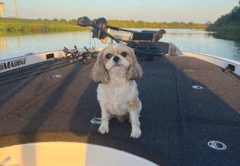Contributors: Norman Lee and John Pate
This is it, after weeks of planning and preparation this is your weekend on the Big ‘0’ and the opportunity to land that once in a lifetime Hall of Fame trophy bass. Prior to taking off you stopped at a local bait shop and loaded up with three dozen wild golden shiners. These lunker attracting magnets set you back and additional $ 75.00 but who cares, this is your weekend. Then as you set up at that first pad of lilies you reach into your baitwell to grab one of those lunker busters and you find they’re all floating belly up, deader than a door nail, and you’re pissed. Was it your fault, was it bad bait, or perhaps the bass gods were not on your side today. So let’s try to minimize the chances of a reoccurrence the next time you buy some wild or domestic shiners.
THE FIRST STEP IN ENSURING YOU HAVE THE LIVELIEST BAIT IS TO CHECK THE BAIT BEFORE YOU BUY IT.
The first step in ensuring you have the liveliest bait is to check the bait before you buy it. Around Lake Okeechobee the vast majority of bait dealers take pride in providing the best baits possible. However there are occasions when supplies are tight and bait fishermen need to travel outside the local area to catch bait or are forced to find bait in less than favorable water conditions. Under these circumstances the bait may already be stressed out or halfway dead so it’s best to know the signs of unhealthy bait. A healthy wild golden shiner should have a golden brown tone to the back and feel soft and slick to the touch. This slick feel is a good indication of a healthy slim coat which is the shiner’s first line of defense against disease. The shiners should also be energetic and a challenge to catch with a dip net. If a shiner is taking on a dark almost black like color or feels rough to the touch, it’s a good indication the shiner is not long for this world. If the bait shop owner will allow it, take a look at his tanks; are they well aerated, is the water clean, is there a build-up of fish droppings or excess food on the bottom of the tank, all these are indicators as to how well the shiners are being kept. A healthy shiner is a frisky shiner.
Once you’re sure you have quality shiners, the next important element is your bait tank or live well. If your boat comes equipped with multiple wells, dedicate one well strictly for your bait and the other wells for your catch. Though the procedures and water conditioners used for maintaining bass and wild shiners are similar there are noticeable differences so they should be kept separate. Some additives such as ‘Finer Shiner’ are great for shiners but are not to be used for fish when they are going to be consumed. Though commercial water additives can improve the survivability and friskiness of your bait it’s important to match the right additive to the right job.
Within the bait well the three most critical criteria are proper oxygen levels, water temperature, and fish density. During the summer months, wild shiners require a higher oxygen level to survive so supplementing your factory installed aerators with a 12-vt bubbler will increase the amount of oxygen available to the shiners. The bait needs oxygen not water current, so just increasing the flow of water with your built-in aerator may actually do more harm than good. Another tip is to turn your aerators on before you go into the bait shop to buy your bait. This will give the water a chance to build up a surplus of oxygen before the introduction of new shiners.
Water temperature plays a shocking important role in the survival of your bait. There is no pun intended here, wild shiners are very sensitive to rapid changes in water temperature and may go into life threatening shock if the differences are too great. Unfortunately there are way too many opportunities where rapid changes in water temperature can occur. The first opportunity is when you transfer your newly purchased bait into your live well. If it’s a cool morning and the bait shop’s tanks are in an enclosed shelter, there could be a 10-15 degree or more difference in water temperature between your tank and the bait shop’s tank, so be careful. If you are faced with a long ride to the lake, your tanks could increase in temperature to where the fish will be expending valuable energy just to stay alive. And lastly once on the lake, if you have been cooling your tanks with jugs of ice, that overly chilled shiner will have a major shock once it hits the sun heated water of the lake.
To minimize the potential for temperature shock, maintain your tank temperature to within 10-degrees of ambient lake temperatures. The best way to do this is to buy an inexpensive thermometer and make it a habit to routinely check your tank temperature through-out the day. Once the temperature starts to rise place small bottles or jugs of frozen water in the well to cool the water. Be careful not to use store bought ice made from city water utilities for it may contain chlorine which will kill your shiners.
The third criteria you want to be aware of in your bait well is overcrowding. Placing too many baits in the well will rapidly degrade the water quality in the tank and deplete the oxygen levels to where you kill-off your bait. This is especially important during the hot summer months. A general rule of thumb is to place no more than 3-dozen medium sized shiners in a 48-quart well and 5-dozen shiners in a 84-quart well.
Now that you have a well maintained bait well it’s important to have the proper bait handling skills. Never handle bait just after pumping gas, priming your outboard engine, or any other circumstance where your hands were in contact with petroleum products. Gas residue in your tank is a sure way of killing your bait. Another thing to watch out for is the condition of the small bait bucket that you use to transfer the bait from the bait shop tanks to your tank. I don’t know how many times I heard bait dealers say a customer complained about being sold bad bait when the bucket they used to transfer bait was used to wash their truck, add chlorine to their swimming pool, or fertilize the lawn.
It’s not rocket science to realize fish don’t like chemicals.
Other important do’s and don’ts is to have more than one dip net onboard your boat as well as spare fuses for your live well aerators. It never fails that if you only have one dip net, you’ll be endlessly chasing the last few remaining shiners around the tank with your bare hands until they are exhausted and you are frustrated. Once you have your bait in hand, get them hooked and overboard as quickly as you can.
To extend the lifespan of your shiner, you should use an appropriate sized hook for the size of the bait and hooked them without damaging any vital organs or nerve systems. Hooking a shiner from the bottom jaw through the upper jaw coming out just in front of the nostrils will make the bait swim downward. Placing slight pressure on the line will cause the shiner’s head to turn in the direction of the tension which will give you some control as to where the bait is swimming to. This method also increases the chances of the shiner swimming back to the boat. Hooking the shiner just in front of the dorsal fin will make the bait swim on the surface and away from the boat. Hooking them just behind the dorsal fin will allow the shiner to swim in a more natural presentation but you’ll have less control as to which direction the shiner will swim to.
Lastly, how you cast the shiner will greatly impact how long your shiner will stay alive. If you cast your shiner with a high arch as if you’re shooting a howitzer artillery piece, your shiner will hit the water with a big slap and might not recover from just one cast let alone multiple casts. To get the most out of your shiner, cast under hand or with a sidearm motion to keep the bait low to the water and at a lower velocity. Once the shiner is near your spot, let him do the work. Constant tugging and retrieving will only wear the shiner out and make him less attractive to Mr. Bass.
Fishing with wild golden shiners on Lake Okeechobee or any of the Florida lakes is the most consistent way to catch trophy sized bass. One of the keys to success is to have well maintained and lively shiners. Treat your shiners well and they will reward you with a lifetime of memories.
Credits:
Norman Lee is the show room manager for Lake Placid Marine and he is a Senior Field Representative and Pro-staff member for Tuscaroran Pro-Lures. He is also a successful tournament angler and community activist.
John Pate is the owner of South Florida Bass Guides. He is a Senior Field Representative and Pro-staff member for Tuscaroran Pro-Lures. He has been a successful tournament angler for over 38-years.






